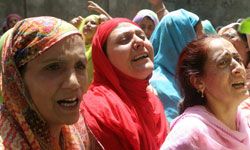
Key Takeaways
- Muslim funeral traditions emphasize simplicity, dignity and respect for the deceased.
- Key rituals include prompt burial, washing and shrouding the body and offering funeral prayers.
- These customs reflect Islamic beliefs about death, the afterlife and the importance of community support during mourning.
Coping with the loss of a friend or family member is difficult, no matter what your faith. All religions have funeral rites and traditions for dealing with death, and Islam is no different.
With Osama bin Laden's recent death and burial at sea, there's been a lot of speculation about Muslim funeral traditions. Muslims have a pretty clear set of rules when it comes to preparing the dead for burial and for the funeral itself.
Advertisem*nt
Not only are there Muslim funeral traditions, but there are rituals and recommendations for Muslims close to a person who is dying, like saying positive things, making sure that he feels safe and is never alone, and gently encouraging the dying person to accept Allah and say the Shahaadah (a declaration of faith).
Muslims believe in similar constructs to heaven and hell, referred to as Jannah (paradise or heaven) and Jahannam (hell). Many Muslims believe that by accepting Islam, even just before death, and saying the Shahaadah, the dying person will go to Jannah after death.
So, what are the Muslim traditions for a funeral and burial? The rituals begin just after death.
Contents
- Just After Death
- Mourning
- Washing the Dead
- Shrouding the Body
- Funeral Prayer
- The Funeral
- Transporting the Body
- Muslim Burial Traditions
- Marking and Visiting the Grave
- Consoling Family and Friends
10: Just After Death
As soon as a Muslim person dies, it's customary to close the eyes, bind the jaw and cover the body with a clean sheet. It's also important to prepare the body for the funeral as quickly as possible. Ideally, the funeral will take place before the next sunset or within 24 hours.
While there are Muslims who believe that it's important to make sure that the body faces toward Mecca, and that you should place a copy of the Quran under the deceased person's head, these traditions are controversial. Some scholars say that there is no precedent for doing these things.
Advertisem*nt
As we'll see next, there are even rules for mourning the dead, including special rules for widows.
9: Mourning

Hidaad, or mourning, for a close relative should last only three days, and there are guidelines about how that mourning should take shape. Weeping is acceptable, but the Islamic faith discourages loud crying and acting out during the mourning period. Conservative Muslims believe that the person's spirit can hear these cries, and they cause the spirit anguish.
There's a special mourning period for women who have lost a husband. It's called the 'Iddah (or Edda), and it lasts four months and 10 days. During that time, the woman is not allowed to wear perfume or jewelry, and she can only leave the house for work and errands. She can visit friends and family, but during the 'Iddah, she's required to sleep at home and can't remarry until the period is over.
Before the funeral, Muslims go through a washing ritual to prepare the corpse. Check out details on the next page.
8: Washing the Dead
Before the funeral, the deceased's family follows traditional Islamic washing rites. It's important that the people who perform the washing also be Muslim and of the same sex as the deceased. The only exceptions are for children or spouses.
The washing requires following very specific rules. After placing the body on a high table and saying, "In the name of Allah," the washers use cloths to methodically clean the body, top to bottom and left to right, repeating the process three to seven times until the body is clean.
Advertisem*nt
Once the deceased is clean and dry, it's time to shroud the body.
7: Shrouding the Body

There are different rules for shrouding male and female Muslims. To wrap a male Muslim corpse, you use three white sheets and four ropes. After placing the man's hands on his chest, right hand on top of left hand, you wrap each sheet, right side first, over the body. To finish the shrouding, tie two ropes just above the head and just below the feet, and use the other two ropes to secure the sheets around the body.
For women, the wrappings are much more intricate. The corpse wears a loose-fitting, sleeveless dress, a head veil and a loin cloth. All of that goes underneath the same sheets and ropes that you'd use to wrap a male corpse.
Advertisem*nt
Muslim tradition stresses that once a person dies, the burial should happen as soon as possible, so it's important to begin the funeral as soon as the shrouding is complete.
6: Funeral Prayer
Even Muslims who aren't close with the deceased or the family can participate in this ritual, the Salatul Janazah.
Before burial, it's traditional to pray over a Muslim body, no matter how old the person was when he or she died. The prayer should happen immediately after shrouding the body. It usually occurs outside of the mosque and its prayer room, and the prayer should take place at dusk or sunset, if possible, unless the body is decomposing and needs to be buried immediately.
Advertisem*nt
Muslims gather in a group to pray silently that Allah will have mercy on this person and all other dead Muslims. There are only two parts of the prayer said aloud, and we'll get to the funeral service in more detail on the next page.
5: The Funeral

Funeral attendees stand in three horizontal lines facing toward Mecca: men in the front row, children in the second row and women in the third row. Like the silent prayer, this occurs outside of the mosque, if possible, and the entire prayer service takes place standing. Participants silently set pure intentions for the funeral service, and then they silently recite the Fatihah, the first section of the Quran. This seven-verse prayer asks for Allah's mercy and guidance.
After the silent Fatihah, there are four more prayers in a traditional Muslim funeral service. Before each of the next four prayers, attendees say, "Allahu Akbar," which basically means "God is good." The four prayers are the Tahahood, a prayer to the prophet Muhammad, and three personal prayers for the deceased. If the funeral is for a child, the third personal prayer is often for the child's parents.
Advertisem*nt
After the funeral, it's time to move the body to the cemetery for burial. As we'll see next, this transportation has some traditions of its own.
4: Transporting the Body
Traditionally, several men carry the body to the cemetery on foot, and funeral goers follow behind. In modern times, the body can be transported in a hearse with a funeral procession behind it.
The car or truck transporting the body shouldn't be a military vehicle, and the funeral procession should happen in silence. No singing, loud crying or reading the Quran is allowed. There should also be no incense or candles in the funeral procession.
Advertisem*nt
Because of the rules about a quick burial, it's traditional to bury a Muslim where he or she died. That means that a Muslim who dies in another country or a remote location should be buried there, not transported back home for burial.
Muslim graves also need to be dug in a very specific way. We'll look at Muslim burial traditions on the next page.
3: Muslim Burial Traditions
Traditionally, a Muslim body should be buried in a Muslim cemetery, and no women or children are allowed at the grave site during the burial.
The body should be buried in a hole deep enough to contain the smell as the body decomposes and to keep animals from digging it up, and it's considered desecration to cremate a Muslim corpse. The body goes into the grave on its right side, facing Mecca, ideally not inside of a coffin. If the cemetery is located in a place with abundant wildlife, sometimes Muslims will cover the grave with bricks or stones to keep animals from disturbing the body.
Advertisem*nt
If a Muslim dies at sea, and it's not possible to get the body to land within 24 hours after death, then a burial at sea is allowed.
Burial in Space
What happens if a Muslim working on the International Space Station dies? The Malaysian National Space Agency put together a set of guidelines for Muslims working in space, and they include instructions on burial. If possible, the body should head back to Earth for the funeral and burial, but if that can't happen, the person should be buried in space after a simple funeral. However, there aren't any details on how this space burial should take place.
2: Marking and Visiting the Grave
Muslim cemeteries are all about minimalism and deference, so they don't have extravagant grave markers. A small marker or gravestone, however, is fine. Traditionally, you don't put anything for the deceased on or around the grave: This means no cut flowers, candles or other offerings.
There is some debate about whether women can visit the grave of a loved one to remember him. While some Muslims say that this is forbidden, others think it's OK to occasionally visit the grave site to remember the deceased and meditate on mortality.
Advertisem*nt
Muslim tradition even has rules on how to console grieving friends and family, though these aren't as strict as some of the other funeral traditions.
1: Consoling Family and Friends

Consoling grieving friends and family is important in the Muslim community and doesn't have many rigid rules governing how to comfort those in mourning. It's traditional to reach out to the mourning family with sympathy and with food for three days after the funeral.
Like in many other cultures, offering help and condolences to the mourning family is considered an essential part of dealing with death. It's also common to bring food to the mourning family after a Muslim funeral, so that they won't have to worry about details like cooking as they cope with the loss of a loved one.
For more articles on traditions around the world, check out the links on the next page.
Frequently Asked Questions
Can non-Muslims attend Muslim funerals?
Yes, non-Muslims may attend Muslim funerals as a sign of respect and solidarity with the bereaved family. However, it's important to observe and respect Islamic customs and practices during the funeral proceedings.
What should one wear to a Muslim funeral?
It's recommended to dress modestly and conservatively, covering arms, legs and shoulders out of respect for Islamic traditions. Neutral colors are preferred, and women may consider wearing a headscarf as a sign of respect.
Lots More Information
Related Articles
- 10 Strange American Traditions
- 10 Native American Music Traditions
- 5 Family Traditions for Daughters
- 10 Family Christian Traditions
- How Ramadan Works
- How Natural Burial Works
Sources
- Aisha, Bilal Abu. "Funeral Rites and Regulations in Islam." Mission Islam. (July 28, 2011) http://www.missionislam.com/knowledge/funeral.htm
- Husseini Islamic Center. "Islamic Etiquette of consoling the bereaved." March 15, 2007. (Aug. 3, 2011) http://docs.google.com/viewer?a=v&q=cache:voW8q5qztS8J:www.orlandocenter.org/downloads/media/presentations/ConsolingTheBereaved.pps+consoling+a+grieving+muslim&hl=en&gl=us&pid=bl&srcid=ADGEESiIda48fFKQ0mcqC8Ry62EBkOHWHHhpeRlnv6A-04hTbjmBLVEmFO8v-E1qcInk8l06iuJrBCvrtwZE9PcwG-GDWP1PMPplQoE-jy0zNf0FF1-i_ZJ1Mzus0jVllHP8HsgAsnsL&sig=AHIEtbSXPmGxdIHqUCA0etO-hglPGal0BA
- Internet Broadcasting. "What Are Islamic Burial Traditions?" Click On Detroit. May 2, 2011. (July 28, 2011) http://www.clickondetroit.com/news/27744484/detail.html
- Malaysian Department of Islamic Development. "A Guideline of Performing Ibadahat the International Space Station (ISS)." Malaysian National Space Agency. (Aug. 3, 2011) http://makkah.files.wordpress.com/2007/10/a_guideline_ibadah_at_iss.pdf
- Me, Myself, and I. "A glossary of Muslim terms." (July 28, 2011) http://www.mmiweb.org.uk/publications/glossary/glossaries/islamglos2.html
- The Muslim Association of Hawai'i. "Muslim Funeral Guide." (July 28, 2011) www.iio.org/janazah/bur_1299.pdf
- Siala, Mohamed Ebrahim. "Authentic Step by Step Illustrated Janazah Guide." Rahma Funeral Home. (July 28, 2011) http://ifsnt.com/Authentic%20Step%20by%20Step%20Illustrated%20Janazah%20Guide.html
Cite This!
Please copy/paste the following text to properly cite this HowStuffWorks.com article:
Citation